Fairprice Company: Supply Base Structuring and Segmentation Report
VerifiedAdded on 2020/04/01
|11
|2069
|36
Report
AI Summary
This report provides a comprehensive analysis of NTUC Fairprice Company's supply base structuring and segmentation strategies. It examines the various segmentation approaches employed, including product-based, supply chain risk-based, manufacturing and technology-based, and market-driven methods. The report delves into the purchasing strategies utilized by Fairprice, such as supplier optimization, Total Quality Management (TQM), risk management, global sourcing, and vendor development. It highlights the benefits Fairprice has gained from its segmentation strategy, such as improved decision-making, increased team flexibility, and alignment of supply chain resources with specific needs. The analysis emphasizes how Fairprice adapts its operations to meet customer needs, reduce production costs, and enhance overall efficiency within its supply chain. The report also references several academic sources to support its findings.
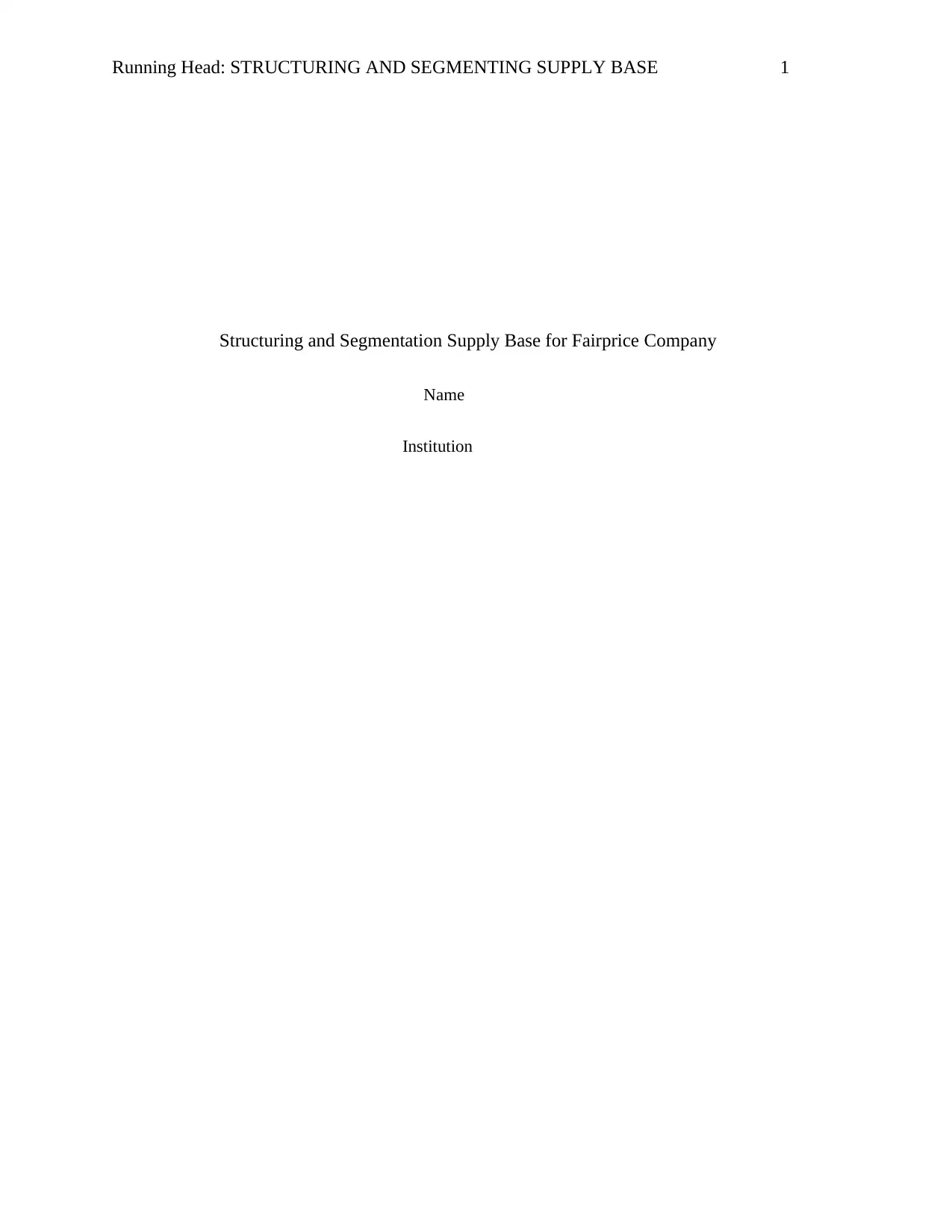
Running Head: STRUCTURING AND SEGMENTING SUPPLY BASE 1
Structuring and Segmentation Supply Base for Fairprice Company
Name
Institution
Structuring and Segmentation Supply Base for Fairprice Company
Name
Institution
Paraphrase This Document
Need a fresh take? Get an instant paraphrase of this document with our AI Paraphraser
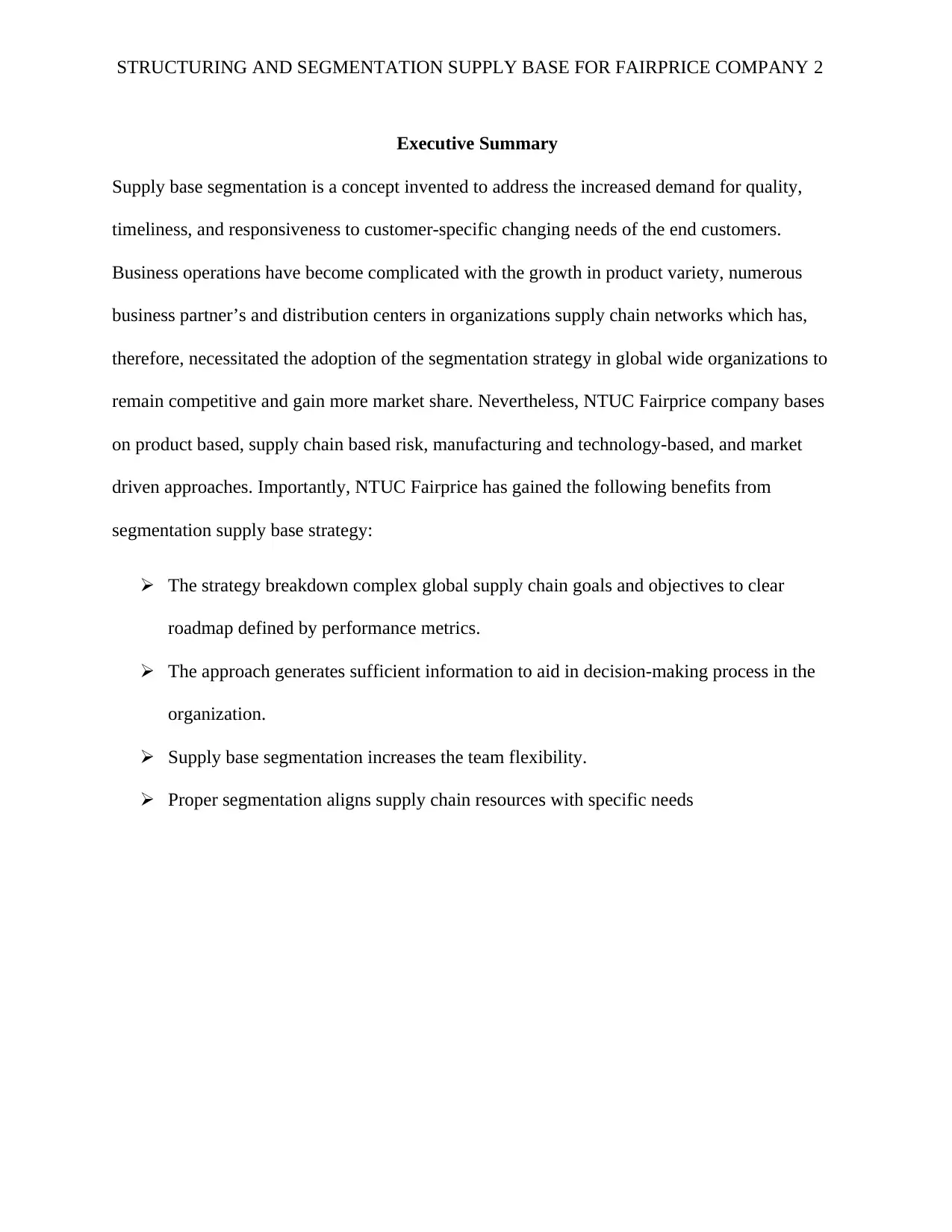
STRUCTURING AND SEGMENTATION SUPPLY BASE FOR FAIRPRICE COMPANY 2
Executive Summary
Supply base segmentation is a concept invented to address the increased demand for quality,
timeliness, and responsiveness to customer-specific changing needs of the end customers.
Business operations have become complicated with the growth in product variety, numerous
business partner’s and distribution centers in organizations supply chain networks which has,
therefore, necessitated the adoption of the segmentation strategy in global wide organizations to
remain competitive and gain more market share. Nevertheless, NTUC Fairprice company bases
on product based, supply chain based risk, manufacturing and technology-based, and market
driven approaches. Importantly, NTUC Fairprice has gained the following benefits from
segmentation supply base strategy:
The strategy breakdown complex global supply chain goals and objectives to clear
roadmap defined by performance metrics.
The approach generates sufficient information to aid in decision-making process in the
organization.
Supply base segmentation increases the team flexibility.
Proper segmentation aligns supply chain resources with specific needs
Executive Summary
Supply base segmentation is a concept invented to address the increased demand for quality,
timeliness, and responsiveness to customer-specific changing needs of the end customers.
Business operations have become complicated with the growth in product variety, numerous
business partner’s and distribution centers in organizations supply chain networks which has,
therefore, necessitated the adoption of the segmentation strategy in global wide organizations to
remain competitive and gain more market share. Nevertheless, NTUC Fairprice company bases
on product based, supply chain based risk, manufacturing and technology-based, and market
driven approaches. Importantly, NTUC Fairprice has gained the following benefits from
segmentation supply base strategy:
The strategy breakdown complex global supply chain goals and objectives to clear
roadmap defined by performance metrics.
The approach generates sufficient information to aid in decision-making process in the
organization.
Supply base segmentation increases the team flexibility.
Proper segmentation aligns supply chain resources with specific needs
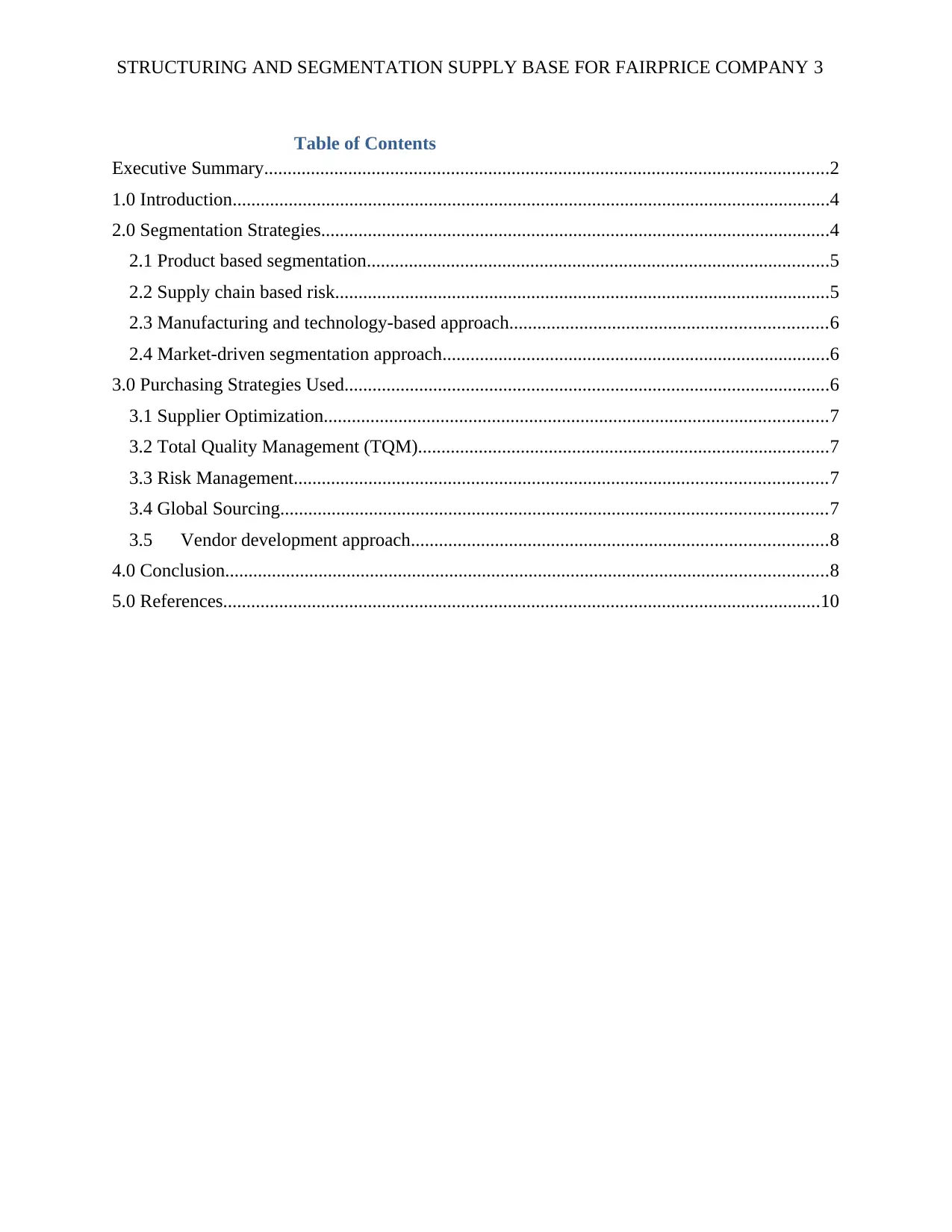
STRUCTURING AND SEGMENTATION SUPPLY BASE FOR FAIRPRICE COMPANY 3
Table of Contents
Executive Summary.........................................................................................................................2
1.0 Introduction................................................................................................................................4
2.0 Segmentation Strategies.............................................................................................................4
2.1 Product based segmentation...................................................................................................5
2.2 Supply chain based risk..........................................................................................................5
2.3 Manufacturing and technology-based approach....................................................................6
2.4 Market-driven segmentation approach...................................................................................6
3.0 Purchasing Strategies Used........................................................................................................6
3.1 Supplier Optimization............................................................................................................7
3.2 Total Quality Management (TQM)........................................................................................7
3.3 Risk Management..................................................................................................................7
3.4 Global Sourcing.....................................................................................................................7
3.5 Vendor development approach.........................................................................................8
4.0 Conclusion.................................................................................................................................8
5.0 References................................................................................................................................10
Table of Contents
Executive Summary.........................................................................................................................2
1.0 Introduction................................................................................................................................4
2.0 Segmentation Strategies.............................................................................................................4
2.1 Product based segmentation...................................................................................................5
2.2 Supply chain based risk..........................................................................................................5
2.3 Manufacturing and technology-based approach....................................................................6
2.4 Market-driven segmentation approach...................................................................................6
3.0 Purchasing Strategies Used........................................................................................................6
3.1 Supplier Optimization............................................................................................................7
3.2 Total Quality Management (TQM)........................................................................................7
3.3 Risk Management..................................................................................................................7
3.4 Global Sourcing.....................................................................................................................7
3.5 Vendor development approach.........................................................................................8
4.0 Conclusion.................................................................................................................................8
5.0 References................................................................................................................................10
⊘ This is a preview!⊘
Do you want full access?
Subscribe today to unlock all pages.

Trusted by 1+ million students worldwide
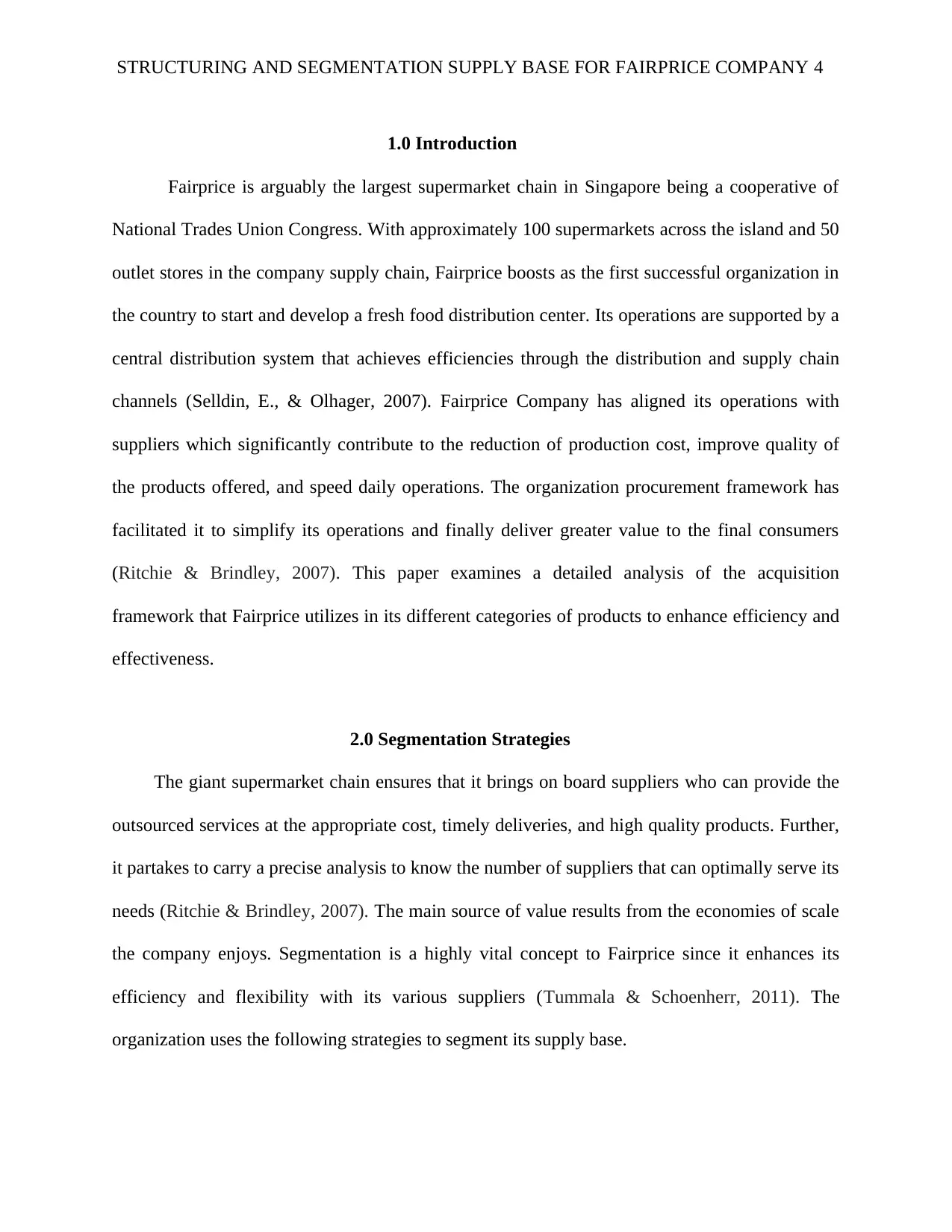
STRUCTURING AND SEGMENTATION SUPPLY BASE FOR FAIRPRICE COMPANY 4
1.0 Introduction
Fairprice is arguably the largest supermarket chain in Singapore being a cooperative of
National Trades Union Congress. With approximately 100 supermarkets across the island and 50
outlet stores in the company supply chain, Fairprice boosts as the first successful organization in
the country to start and develop a fresh food distribution center. Its operations are supported by a
central distribution system that achieves efficiencies through the distribution and supply chain
channels (Selldin, E., & Olhager, 2007). Fairprice Company has aligned its operations with
suppliers which significantly contribute to the reduction of production cost, improve quality of
the products offered, and speed daily operations. The organization procurement framework has
facilitated it to simplify its operations and finally deliver greater value to the final consumers
(Ritchie & Brindley, 2007). This paper examines a detailed analysis of the acquisition
framework that Fairprice utilizes in its different categories of products to enhance efficiency and
effectiveness.
2.0 Segmentation Strategies
The giant supermarket chain ensures that it brings on board suppliers who can provide the
outsourced services at the appropriate cost, timely deliveries, and high quality products. Further,
it partakes to carry a precise analysis to know the number of suppliers that can optimally serve its
needs (Ritchie & Brindley, 2007). The main source of value results from the economies of scale
the company enjoys. Segmentation is a highly vital concept to Fairprice since it enhances its
efficiency and flexibility with its various suppliers (Tummala & Schoenherr, 2011). The
organization uses the following strategies to segment its supply base.
1.0 Introduction
Fairprice is arguably the largest supermarket chain in Singapore being a cooperative of
National Trades Union Congress. With approximately 100 supermarkets across the island and 50
outlet stores in the company supply chain, Fairprice boosts as the first successful organization in
the country to start and develop a fresh food distribution center. Its operations are supported by a
central distribution system that achieves efficiencies through the distribution and supply chain
channels (Selldin, E., & Olhager, 2007). Fairprice Company has aligned its operations with
suppliers which significantly contribute to the reduction of production cost, improve quality of
the products offered, and speed daily operations. The organization procurement framework has
facilitated it to simplify its operations and finally deliver greater value to the final consumers
(Ritchie & Brindley, 2007). This paper examines a detailed analysis of the acquisition
framework that Fairprice utilizes in its different categories of products to enhance efficiency and
effectiveness.
2.0 Segmentation Strategies
The giant supermarket chain ensures that it brings on board suppliers who can provide the
outsourced services at the appropriate cost, timely deliveries, and high quality products. Further,
it partakes to carry a precise analysis to know the number of suppliers that can optimally serve its
needs (Ritchie & Brindley, 2007). The main source of value results from the economies of scale
the company enjoys. Segmentation is a highly vital concept to Fairprice since it enhances its
efficiency and flexibility with its various suppliers (Tummala & Schoenherr, 2011). The
organization uses the following strategies to segment its supply base.
Paraphrase This Document
Need a fresh take? Get an instant paraphrase of this document with our AI Paraphraser
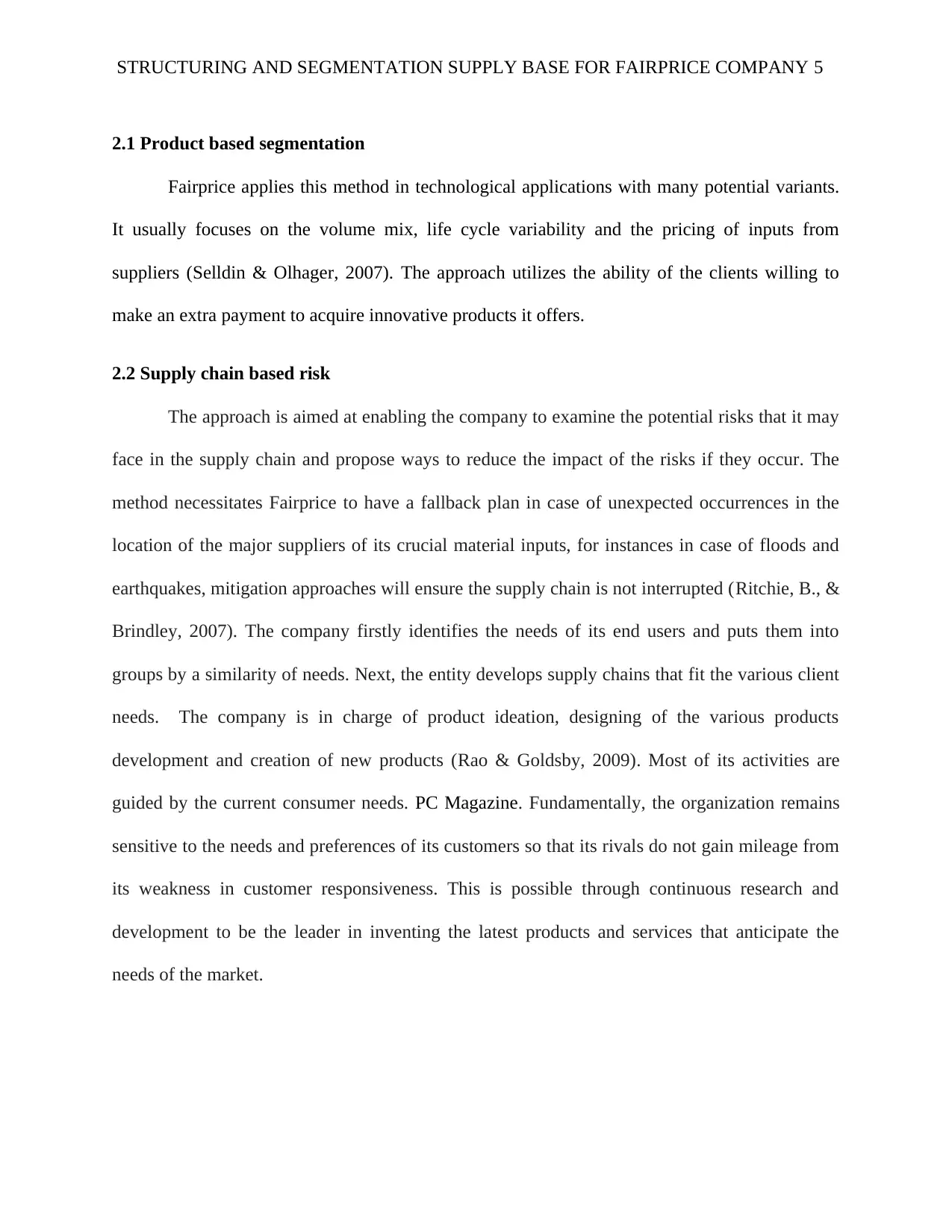
STRUCTURING AND SEGMENTATION SUPPLY BASE FOR FAIRPRICE COMPANY 5
2.1 Product based segmentation
Fairprice applies this method in technological applications with many potential variants.
It usually focuses on the volume mix, life cycle variability and the pricing of inputs from
suppliers (Selldin & Olhager, 2007). The approach utilizes the ability of the clients willing to
make an extra payment to acquire innovative products it offers.
2.2 Supply chain based risk
The approach is aimed at enabling the company to examine the potential risks that it may
face in the supply chain and propose ways to reduce the impact of the risks if they occur. The
method necessitates Fairprice to have a fallback plan in case of unexpected occurrences in the
location of the major suppliers of its crucial material inputs, for instances in case of floods and
earthquakes, mitigation approaches will ensure the supply chain is not interrupted (Ritchie, B., &
Brindley, 2007). The company firstly identifies the needs of its end users and puts them into
groups by a similarity of needs. Next, the entity develops supply chains that fit the various client
needs. The company is in charge of product ideation, designing of the various products
development and creation of new products (Rao & Goldsby, 2009). Most of its activities are
guided by the current consumer needs. PC Magazine. Fundamentally, the organization remains
sensitive to the needs and preferences of its customers so that its rivals do not gain mileage from
its weakness in customer responsiveness. This is possible through continuous research and
development to be the leader in inventing the latest products and services that anticipate the
needs of the market.
2.1 Product based segmentation
Fairprice applies this method in technological applications with many potential variants.
It usually focuses on the volume mix, life cycle variability and the pricing of inputs from
suppliers (Selldin & Olhager, 2007). The approach utilizes the ability of the clients willing to
make an extra payment to acquire innovative products it offers.
2.2 Supply chain based risk
The approach is aimed at enabling the company to examine the potential risks that it may
face in the supply chain and propose ways to reduce the impact of the risks if they occur. The
method necessitates Fairprice to have a fallback plan in case of unexpected occurrences in the
location of the major suppliers of its crucial material inputs, for instances in case of floods and
earthquakes, mitigation approaches will ensure the supply chain is not interrupted (Ritchie, B., &
Brindley, 2007). The company firstly identifies the needs of its end users and puts them into
groups by a similarity of needs. Next, the entity develops supply chains that fit the various client
needs. The company is in charge of product ideation, designing of the various products
development and creation of new products (Rao & Goldsby, 2009). Most of its activities are
guided by the current consumer needs. PC Magazine. Fundamentally, the organization remains
sensitive to the needs and preferences of its customers so that its rivals do not gain mileage from
its weakness in customer responsiveness. This is possible through continuous research and
development to be the leader in inventing the latest products and services that anticipate the
needs of the market.
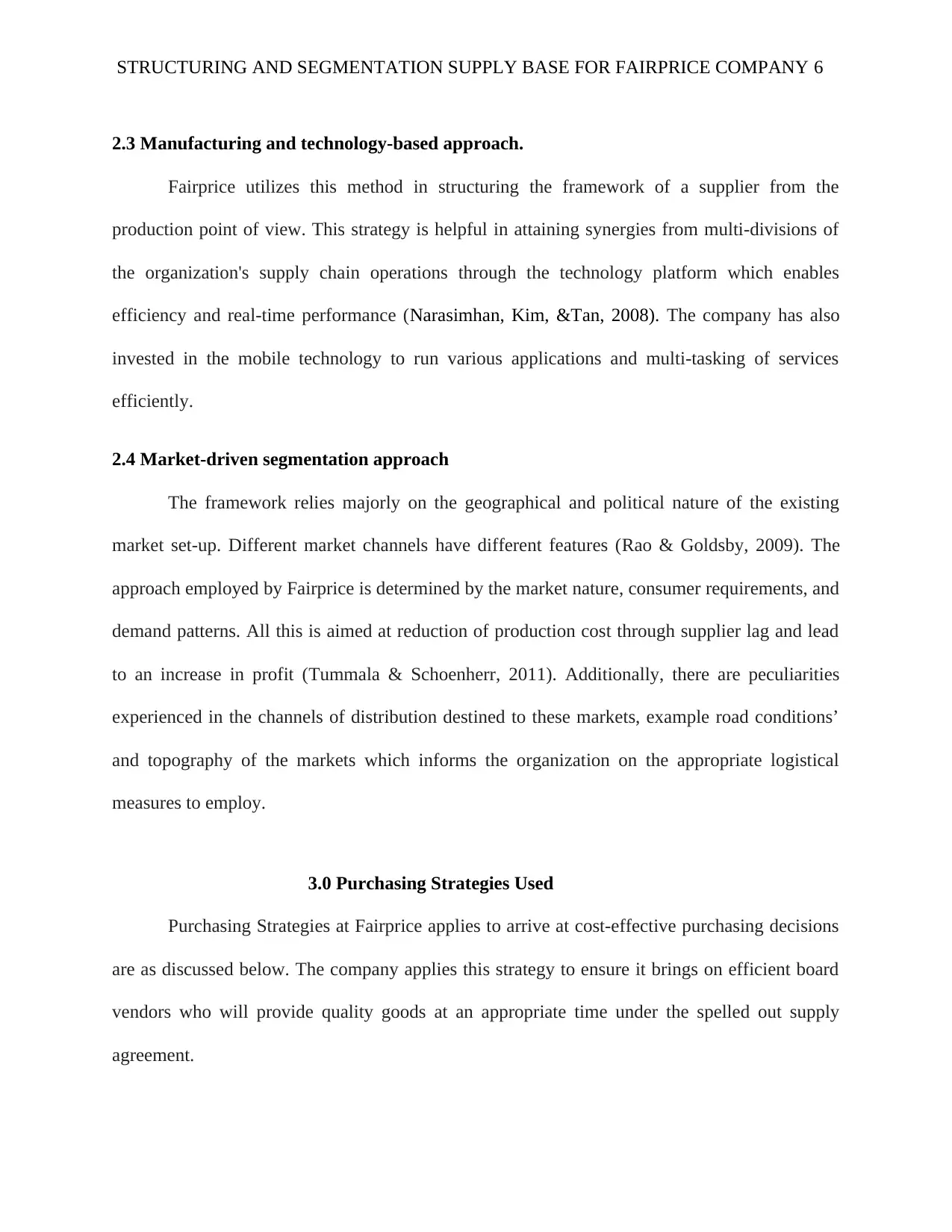
STRUCTURING AND SEGMENTATION SUPPLY BASE FOR FAIRPRICE COMPANY 6
2.3 Manufacturing and technology-based approach.
Fairprice utilizes this method in structuring the framework of a supplier from the
production point of view. This strategy is helpful in attaining synergies from multi-divisions of
the organization's supply chain operations through the technology platform which enables
efficiency and real-time performance (Narasimhan, Kim, &Tan, 2008). The company has also
invested in the mobile technology to run various applications and multi-tasking of services
efficiently.
2.4 Market-driven segmentation approach
The framework relies majorly on the geographical and political nature of the existing
market set-up. Different market channels have different features (Rao & Goldsby, 2009). The
approach employed by Fairprice is determined by the market nature, consumer requirements, and
demand patterns. All this is aimed at reduction of production cost through supplier lag and lead
to an increase in profit (Tummala & Schoenherr, 2011). Additionally, there are peculiarities
experienced in the channels of distribution destined to these markets, example road conditions’
and topography of the markets which informs the organization on the appropriate logistical
measures to employ.
3.0 Purchasing Strategies Used
Purchasing Strategies at Fairprice applies to arrive at cost-effective purchasing decisions
are as discussed below. The company applies this strategy to ensure it brings on efficient board
vendors who will provide quality goods at an appropriate time under the spelled out supply
agreement.
2.3 Manufacturing and technology-based approach.
Fairprice utilizes this method in structuring the framework of a supplier from the
production point of view. This strategy is helpful in attaining synergies from multi-divisions of
the organization's supply chain operations through the technology platform which enables
efficiency and real-time performance (Narasimhan, Kim, &Tan, 2008). The company has also
invested in the mobile technology to run various applications and multi-tasking of services
efficiently.
2.4 Market-driven segmentation approach
The framework relies majorly on the geographical and political nature of the existing
market set-up. Different market channels have different features (Rao & Goldsby, 2009). The
approach employed by Fairprice is determined by the market nature, consumer requirements, and
demand patterns. All this is aimed at reduction of production cost through supplier lag and lead
to an increase in profit (Tummala & Schoenherr, 2011). Additionally, there are peculiarities
experienced in the channels of distribution destined to these markets, example road conditions’
and topography of the markets which informs the organization on the appropriate logistical
measures to employ.
3.0 Purchasing Strategies Used
Purchasing Strategies at Fairprice applies to arrive at cost-effective purchasing decisions
are as discussed below. The company applies this strategy to ensure it brings on efficient board
vendors who will provide quality goods at an appropriate time under the spelled out supply
agreement.
⊘ This is a preview!⊘
Do you want full access?
Subscribe today to unlock all pages.

Trusted by 1+ million students worldwide
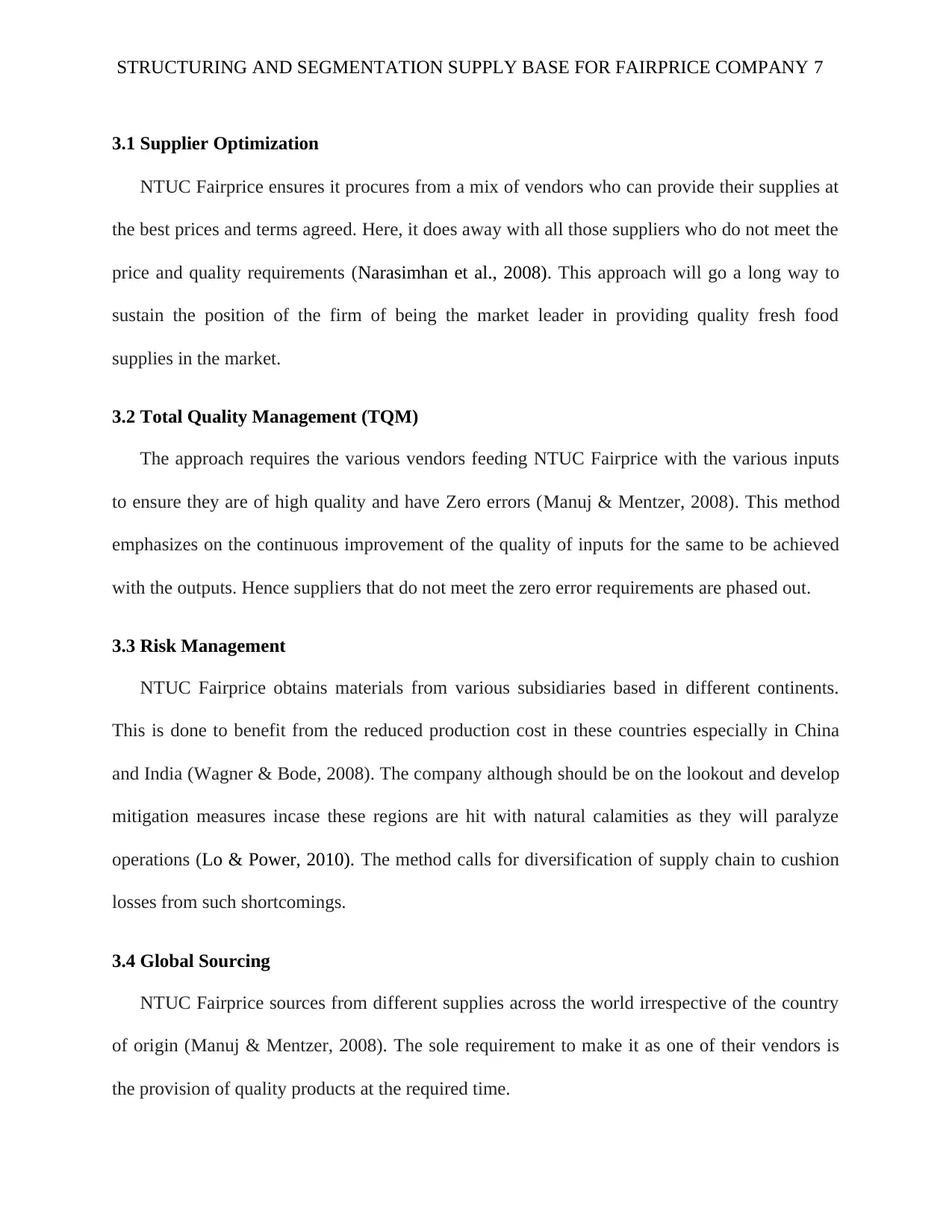
STRUCTURING AND SEGMENTATION SUPPLY BASE FOR FAIRPRICE COMPANY 7
3.1 Supplier Optimization
NTUC Fairprice ensures it procures from a mix of vendors who can provide their supplies at
the best prices and terms agreed. Here, it does away with all those suppliers who do not meet the
price and quality requirements (Narasimhan et al., 2008). This approach will go a long way to
sustain the position of the firm of being the market leader in providing quality fresh food
supplies in the market.
3.2 Total Quality Management (TQM)
The approach requires the various vendors feeding NTUC Fairprice with the various inputs
to ensure they are of high quality and have Zero errors (Manuj & Mentzer, 2008). This method
emphasizes on the continuous improvement of the quality of inputs for the same to be achieved
with the outputs. Hence suppliers that do not meet the zero error requirements are phased out.
3.3 Risk Management
NTUC Fairprice obtains materials from various subsidiaries based in different continents.
This is done to benefit from the reduced production cost in these countries especially in China
and India (Wagner & Bode, 2008). The company although should be on the lookout and develop
mitigation measures incase these regions are hit with natural calamities as they will paralyze
operations (Lo & Power, 2010). The method calls for diversification of supply chain to cushion
losses from such shortcomings.
3.4 Global Sourcing
NTUC Fairprice sources from different supplies across the world irrespective of the country
of origin (Manuj & Mentzer, 2008). The sole requirement to make it as one of their vendors is
the provision of quality products at the required time.
3.1 Supplier Optimization
NTUC Fairprice ensures it procures from a mix of vendors who can provide their supplies at
the best prices and terms agreed. Here, it does away with all those suppliers who do not meet the
price and quality requirements (Narasimhan et al., 2008). This approach will go a long way to
sustain the position of the firm of being the market leader in providing quality fresh food
supplies in the market.
3.2 Total Quality Management (TQM)
The approach requires the various vendors feeding NTUC Fairprice with the various inputs
to ensure they are of high quality and have Zero errors (Manuj & Mentzer, 2008). This method
emphasizes on the continuous improvement of the quality of inputs for the same to be achieved
with the outputs. Hence suppliers that do not meet the zero error requirements are phased out.
3.3 Risk Management
NTUC Fairprice obtains materials from various subsidiaries based in different continents.
This is done to benefit from the reduced production cost in these countries especially in China
and India (Wagner & Bode, 2008). The company although should be on the lookout and develop
mitigation measures incase these regions are hit with natural calamities as they will paralyze
operations (Lo & Power, 2010). The method calls for diversification of supply chain to cushion
losses from such shortcomings.
3.4 Global Sourcing
NTUC Fairprice sources from different supplies across the world irrespective of the country
of origin (Manuj & Mentzer, 2008). The sole requirement to make it as one of their vendors is
the provision of quality products at the required time.
Paraphrase This Document
Need a fresh take? Get an instant paraphrase of this document with our AI Paraphraser
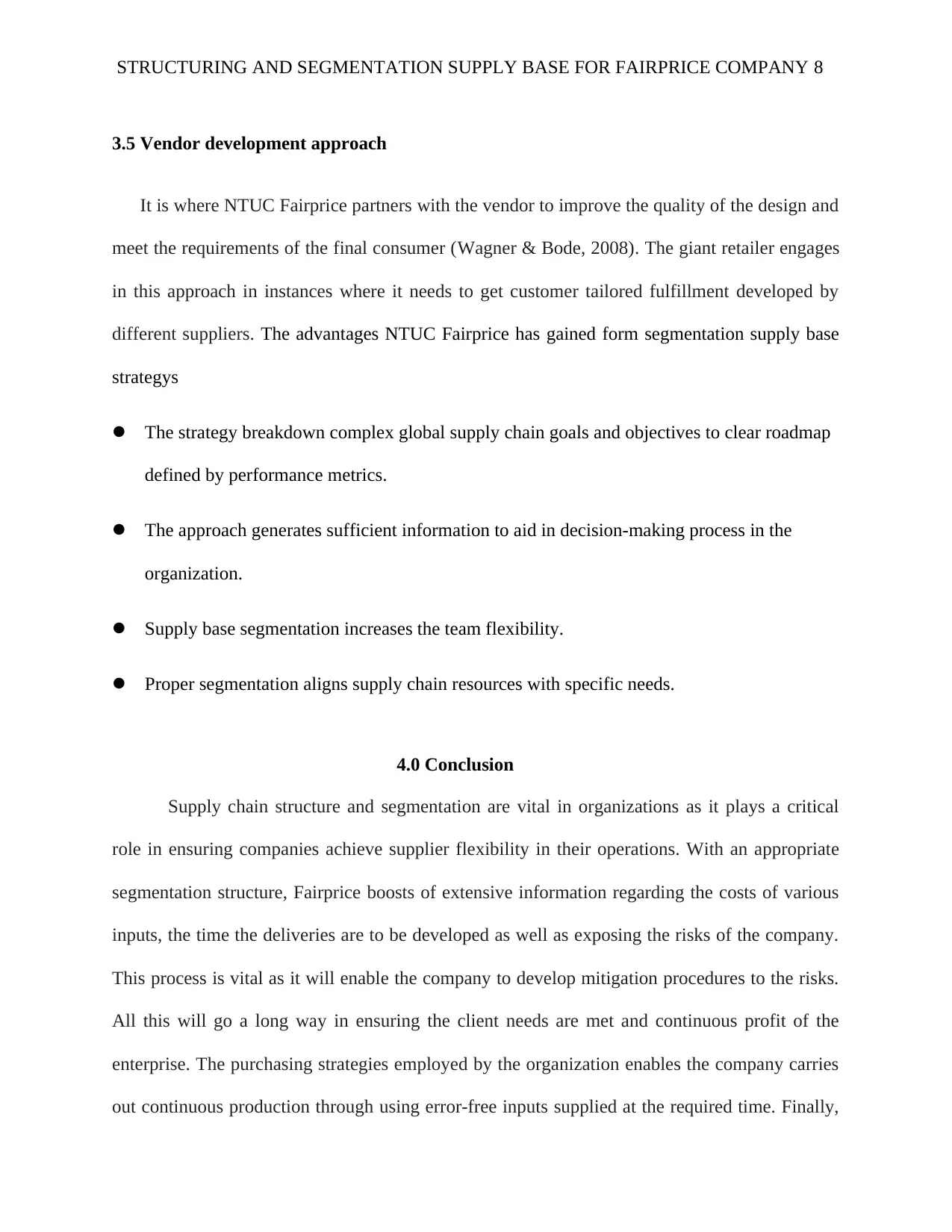
STRUCTURING AND SEGMENTATION SUPPLY BASE FOR FAIRPRICE COMPANY 8
3.5 Vendor development approach
It is where NTUC Fairprice partners with the vendor to improve the quality of the design and
meet the requirements of the final consumer (Wagner & Bode, 2008). The giant retailer engages
in this approach in instances where it needs to get customer tailored fulfillment developed by
different suppliers. The advantages NTUC Fairprice has gained form segmentation supply base
strategys
The strategy breakdown complex global supply chain goals and objectives to clear roadmap
defined by performance metrics.
The approach generates sufficient information to aid in decision-making process in the
organization.
Supply base segmentation increases the team flexibility.
Proper segmentation aligns supply chain resources with specific needs.
4.0 Conclusion
Supply chain structure and segmentation are vital in organizations as it plays a critical
role in ensuring companies achieve supplier flexibility in their operations. With an appropriate
segmentation structure, Fairprice boosts of extensive information regarding the costs of various
inputs, the time the deliveries are to be developed as well as exposing the risks of the company.
This process is vital as it will enable the company to develop mitigation procedures to the risks.
All this will go a long way in ensuring the client needs are met and continuous profit of the
enterprise. The purchasing strategies employed by the organization enables the company carries
out continuous production through using error-free inputs supplied at the required time. Finally,
3.5 Vendor development approach
It is where NTUC Fairprice partners with the vendor to improve the quality of the design and
meet the requirements of the final consumer (Wagner & Bode, 2008). The giant retailer engages
in this approach in instances where it needs to get customer tailored fulfillment developed by
different suppliers. The advantages NTUC Fairprice has gained form segmentation supply base
strategys
The strategy breakdown complex global supply chain goals and objectives to clear roadmap
defined by performance metrics.
The approach generates sufficient information to aid in decision-making process in the
organization.
Supply base segmentation increases the team flexibility.
Proper segmentation aligns supply chain resources with specific needs.
4.0 Conclusion
Supply chain structure and segmentation are vital in organizations as it plays a critical
role in ensuring companies achieve supplier flexibility in their operations. With an appropriate
segmentation structure, Fairprice boosts of extensive information regarding the costs of various
inputs, the time the deliveries are to be developed as well as exposing the risks of the company.
This process is vital as it will enable the company to develop mitigation procedures to the risks.
All this will go a long way in ensuring the client needs are met and continuous profit of the
enterprise. The purchasing strategies employed by the organization enables the company carries
out continuous production through using error-free inputs supplied at the required time. Finally,
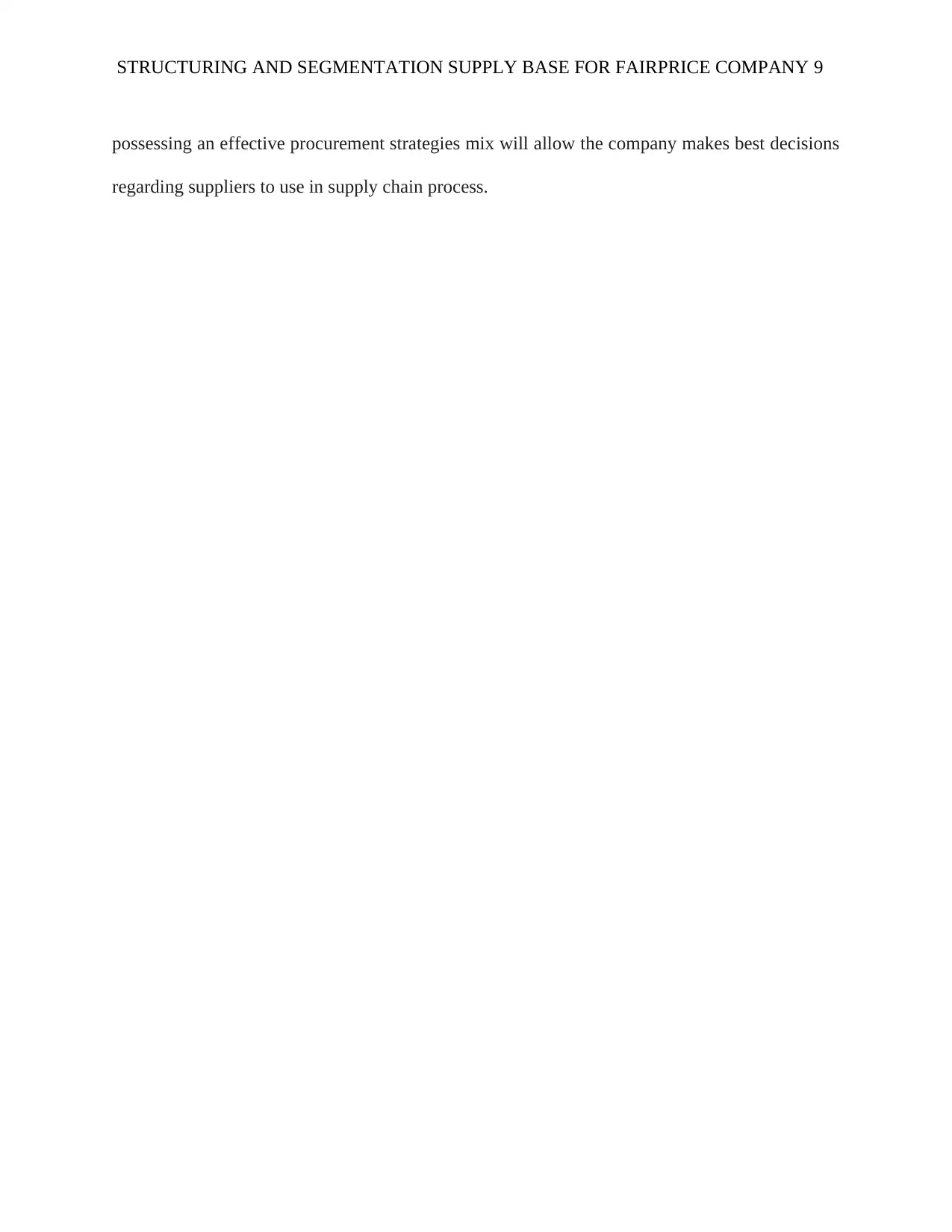
STRUCTURING AND SEGMENTATION SUPPLY BASE FOR FAIRPRICE COMPANY 9
possessing an effective procurement strategies mix will allow the company makes best decisions
regarding suppliers to use in supply chain process.
possessing an effective procurement strategies mix will allow the company makes best decisions
regarding suppliers to use in supply chain process.
⊘ This is a preview!⊘
Do you want full access?
Subscribe today to unlock all pages.

Trusted by 1+ million students worldwide
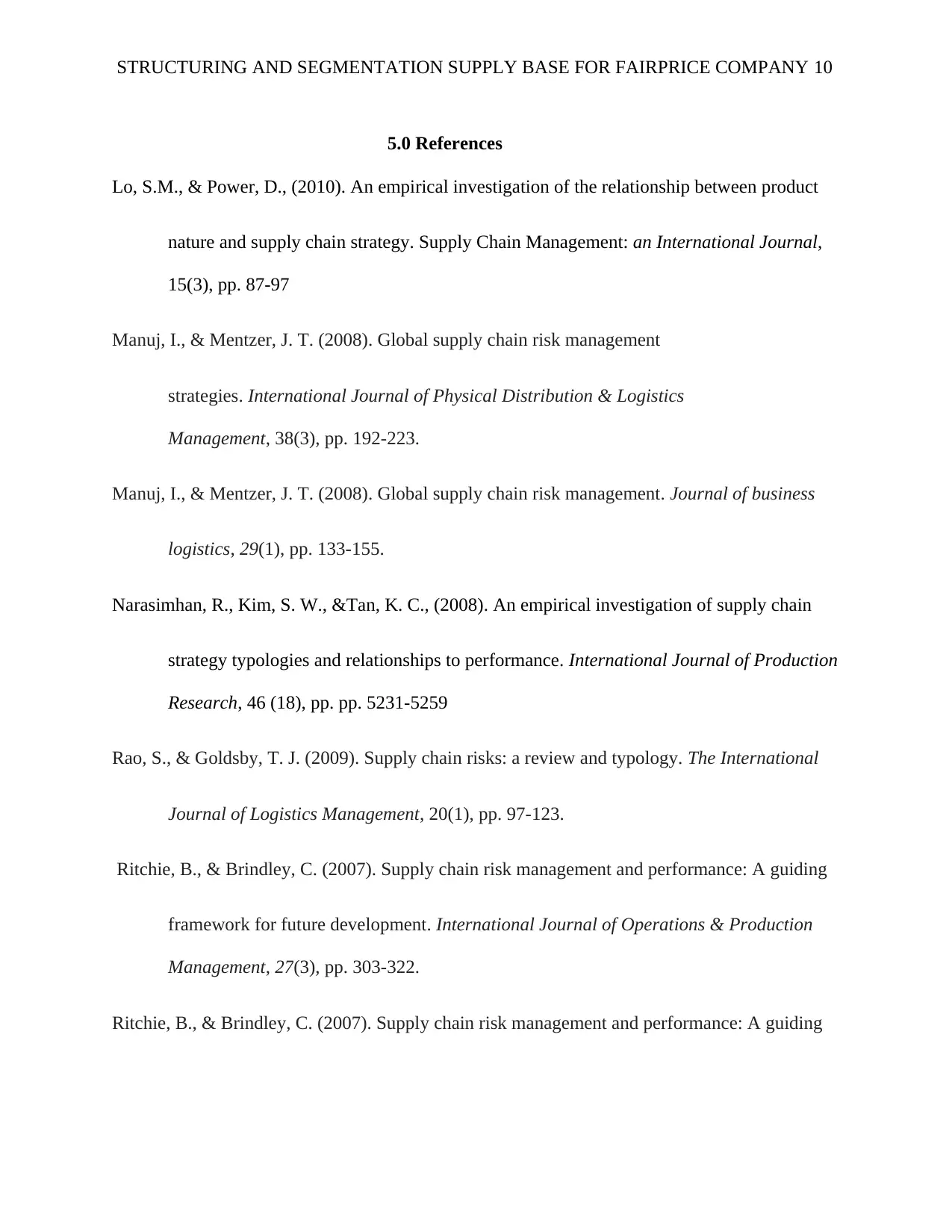
STRUCTURING AND SEGMENTATION SUPPLY BASE FOR FAIRPRICE COMPANY 10
5.0 References
Lo, S.M., & Power, D., (2010). An empirical investigation of the relationship between product
nature and supply chain strategy. Supply Chain Management: an International Journal,
15(3), pp. 87-97
Manuj, I., & Mentzer, J. T. (2008). Global supply chain risk management
strategies. International Journal of Physical Distribution & Logistics
Management, 38(3), pp. 192-223.
Manuj, I., & Mentzer, J. T. (2008). Global supply chain risk management. Journal of business
logistics, 29(1), pp. 133-155.
Narasimhan, R., Kim, S. W., &Tan, K. C., (2008). An empirical investigation of supply chain
strategy typologies and relationships to performance. International Journal of Production
Research, 46 (18), pp. pp. 5231-5259
Rao, S., & Goldsby, T. J. (2009). Supply chain risks: a review and typology. The International
Journal of Logistics Management, 20(1), pp. 97-123.
Ritchie, B., & Brindley, C. (2007). Supply chain risk management and performance: A guiding
framework for future development. International Journal of Operations & Production
Management, 27(3), pp. 303-322.
Ritchie, B., & Brindley, C. (2007). Supply chain risk management and performance: A guiding
5.0 References
Lo, S.M., & Power, D., (2010). An empirical investigation of the relationship between product
nature and supply chain strategy. Supply Chain Management: an International Journal,
15(3), pp. 87-97
Manuj, I., & Mentzer, J. T. (2008). Global supply chain risk management
strategies. International Journal of Physical Distribution & Logistics
Management, 38(3), pp. 192-223.
Manuj, I., & Mentzer, J. T. (2008). Global supply chain risk management. Journal of business
logistics, 29(1), pp. 133-155.
Narasimhan, R., Kim, S. W., &Tan, K. C., (2008). An empirical investigation of supply chain
strategy typologies and relationships to performance. International Journal of Production
Research, 46 (18), pp. pp. 5231-5259
Rao, S., & Goldsby, T. J. (2009). Supply chain risks: a review and typology. The International
Journal of Logistics Management, 20(1), pp. 97-123.
Ritchie, B., & Brindley, C. (2007). Supply chain risk management and performance: A guiding
framework for future development. International Journal of Operations & Production
Management, 27(3), pp. 303-322.
Ritchie, B., & Brindley, C. (2007). Supply chain risk management and performance: A guiding
Paraphrase This Document
Need a fresh take? Get an instant paraphrase of this document with our AI Paraphraser
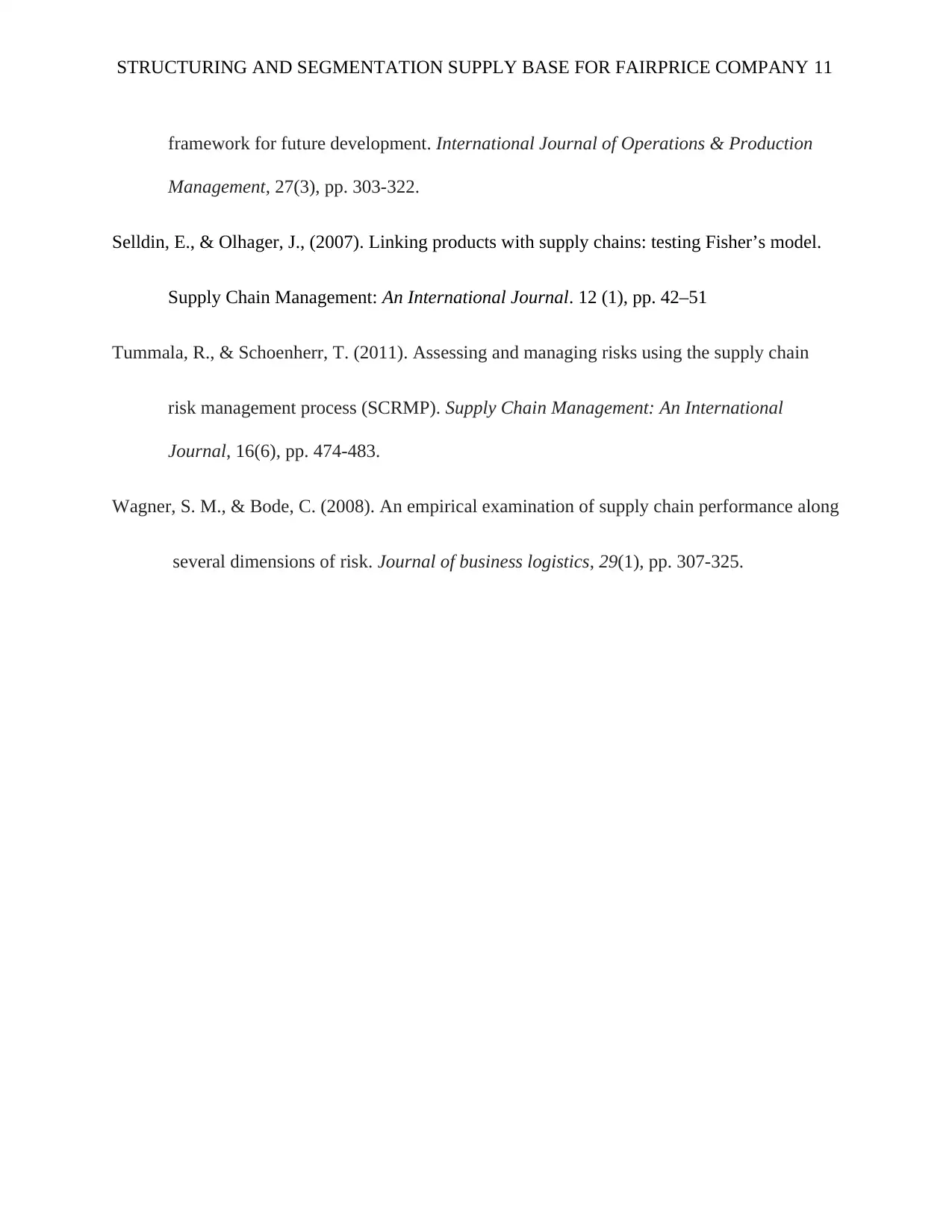
STRUCTURING AND SEGMENTATION SUPPLY BASE FOR FAIRPRICE COMPANY 11
framework for future development. International Journal of Operations & Production
Management, 27(3), pp. 303-322.
Selldin, E., & Olhager, J., (2007). Linking products with supply chains: testing Fisher’s model.
Supply Chain Management: An International Journal. 12 (1), pp. 42–51
Tummala, R., & Schoenherr, T. (2011). Assessing and managing risks using the supply chain
risk management process (SCRMP). Supply Chain Management: An International
Journal, 16(6), pp. 474-483.
Wagner, S. M., & Bode, C. (2008). An empirical examination of supply chain performance along
several dimensions of risk. Journal of business logistics, 29(1), pp. 307-325.
framework for future development. International Journal of Operations & Production
Management, 27(3), pp. 303-322.
Selldin, E., & Olhager, J., (2007). Linking products with supply chains: testing Fisher’s model.
Supply Chain Management: An International Journal. 12 (1), pp. 42–51
Tummala, R., & Schoenherr, T. (2011). Assessing and managing risks using the supply chain
risk management process (SCRMP). Supply Chain Management: An International
Journal, 16(6), pp. 474-483.
Wagner, S. M., & Bode, C. (2008). An empirical examination of supply chain performance along
several dimensions of risk. Journal of business logistics, 29(1), pp. 307-325.
1 out of 11
Related Documents
Your All-in-One AI-Powered Toolkit for Academic Success.
+13062052269
info@desklib.com
Available 24*7 on WhatsApp / Email
![[object Object]](/_next/static/media/star-bottom.7253800d.svg)
Unlock your academic potential
Copyright © 2020–2025 A2Z Services. All Rights Reserved. Developed and managed by ZUCOL.





